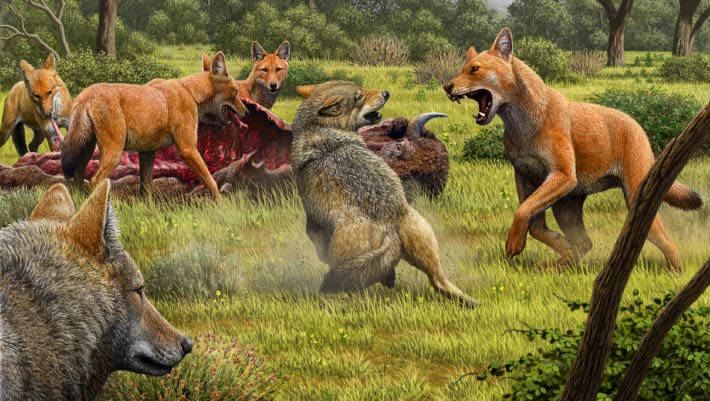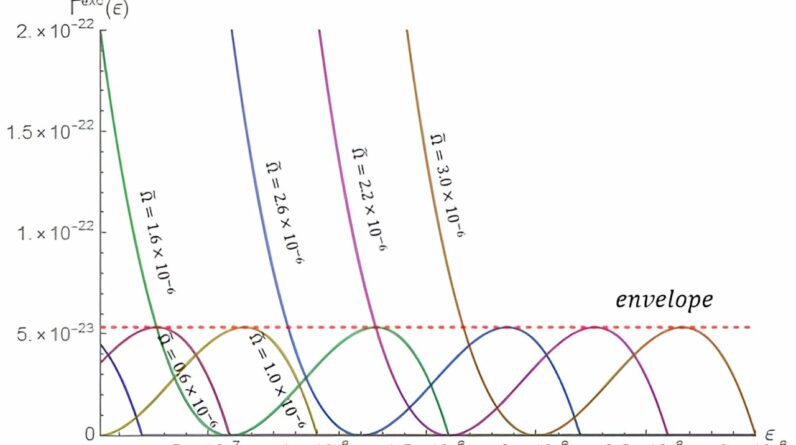
Awesome wolves (The dog fades) It is considered one of the most common and widespread carnivores of the Pleistocene in America, yet relatively little is known about its evolution or extinction. Previous analyzes, based on morphology alone, led scientists to believe that these long-extinct dogs were closely related to hadith. Gray wolves (the gray wolf). To reconstruct the evolutionary history of dire wolves, an international team of genetic researchers has sequenced five genomes from fossil remains dating from 12,900 to more than 50,000 years ago. they ResultsPublished in the journal nature, Indicates that dire wolves were a separate breed that separated from living dogs about 5.7 million years ago.
Somewhere in southwestern North America during the late Ice Age, a group of dire wolves (The dog fades(Feeding on killing bulls, while a pair of gray wolves)the gray wolf) In the hope of scavenging. A terrible wolf rushes to confront the Gray Wolves, and their encounter allows for the comparison of the larger wolf with a larger head and a reddish brown to its smaller gray relative. Image credit: Mauricio Anton / nature.
Wolves were terrible Canidae are large wolf-like – about 68 kg, about 25% heavier than gray wolves – among the most common extinct carnivores of the late American Pleistocene Gigantic.
Their remains are in the fossil record in North America from at least 250,000 to about 13,000 years ago, at the end of the Pleistocene Age.
Other species that were present in the late Pleistocene in North America include the slightly smaller, much smaller gray wolf American wolf – coyote (Canis Latran) And the Hole (Cuon alpinus), Although it appears that dire wolves were more common in general.
Terrible wolves are generally described as a sister species, or even identified with gray wolves.
The main hypothesis to explain their extinction was that due to their larger body size compared to gray wolves and coyote wolves, dire wolves were more specialized in hunting large prey and were unable to survive the extinction of their massive prey.
“Terrible wolves have always been an iconic representation of the last ice age in the Americas and are now an icon of pop culture thanks to Game of Thrones, but what we know about their evolutionary history has been limited to what we can see in size and shape,” said co-author Dr. Angela Berry, a researcher in the archeology department at Durham University, “From Their Bones and Teeth”.
“With this first ancient DNA analysis of dire wolves, we discovered that the history of terrible wolves that we thought we knew is actually much more complex than we previously thought.”
“Instead of being closely related to other dog species in North America, such as gray wolves and coyotes, we found that dire wolves represent a branch that separated from others millions of years ago, and represents the last breed that is now extinct.”
Co-author Professor Robert Wayne said, “The terrifying terrible wolf, a mythical symbol of Los Angeles and La Brea Tar Pits, has gained its place among the many large and unique species that became extinct at the end of the Pleistocene era.” Researcher in the Department of Ecology and Evolutionary Biology at the University of California, Los Angeles.
“Terrible wolves are sometimes portrayed as mythical creatures – gigantic wolves wandering around in icy, grim landscapes – but the reality turns out to be a lot more interesting,” said co-lead author Dr. Keren Mitchell, a researcher at the University’s Ancient DNA Center Australia. From Adelaide.
For the study, researchers examined 46 fossil subsamples of dire wolves for the presence of preserved DNA.
They identified five samples from Idaho, Ohio, Tennessee and Wyoming, dating between 12,900 and more than 50,000 years ago, that possessed enough DNA to obtain nuclear and mitochondrial genome sequences.
They found no evidence of gene flow between dire wolves, gray wolves of North America, or coyotes.
The absence of any genetic transmission indicates that dire wolves evolved in isolation from the Ice Age ancestors of these other species.
“We found that the terrible wolf is not closely related to the gray wolf,” said co-author Dr. Alice Mouton, a researcher in the Department of Ecology and Evolutionary Biology at the University of California, Los Angeles.
“Moreover, we show that the dire wolf never mated with the gray wolf. In contrast, gray wolves, African wolves, dogs, coyotes, and jackals can mate and breed.”
“Terrible wolves likely diverged from gray wolves more than 5 million years ago, and it was a big surprise that this difference occurred very early on. This result highlights just how distinct and unique the terrible wolf is.”
The ancestors of gray wolves and much smaller coyote wolves evolved in Eurasia and are believed to have migrated to North America less than 1.37 million years ago, relatively late in the time of evolution.
On the other hand, the dire wolf, based on its genetic difference from those species, is now thought to have originated in the Americas.
The authors also suggest that the dire wolves’ stark evolutionary difference from gray wolves places them into an entirely different race. Enocion, As first proposed by paleontologist John Campbell Miriam more than 100 years ago.
“When we first started this study, we thought that the dire wolves were just ferocious gray wolves, so we were surprised to find out how so genetically they were so different, that they likely did not mate,” said lead author professor. Laurent Frantz is a researcher in the School of Biological and Chemical Sciences at Queen Mary University of London and the Department of Veterinary Sciences at Ludwig Maximilian University.
“This should mean that dire wolves have been isolated in North America for a very long time to become genetically distinct.”
_____
AR Berry Et al. The terrible wolves were the last of the ancient dog breed in the New World. naturePosted on the Internet Jan 13, 2021; Doi: 10.1038 / s41586-020-03082-x






